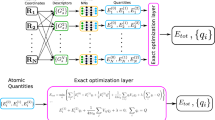Abstract
The model of theoretical potential function represented by networks has been proposed. Quantum chemicalab initio method is used to ralculnte the interionic potential of molten salt systems. The physical contents of network potential are indicated with Born-Mayer-Huggins empirical potential functions, whose deviation from the theoretical potential owing to its approximation is corrected using back propagation artificial neural networks (BP-ANN). Preliminary results have shown that the theoretical potential function networks are useful for the computer simulations of molten salt systems
Similar content being viewed by others
References
Wang Ziyi, Hwang Jenq-neng, Bruce, K. K., Chemnets: Theory and Application,Anal, Chem., 1995, 67: 1497.
Sangster, M. J. L., Dixon, M., Interionic potential in alkali halides and their use in sirnulationn of the molten salts,Adv. Phys., 1976, 25: 247.
Author information
Authors and Affiliations
About this article
Cite this article
Honglin, L., Liman, Q. & Xiaowei, C. Theoretical potential function represented by networks. Chin. Sci. Bull. 43, 964–967 (1998). https://doi.org/10.1007/BF02884625
Received:
Issue Date:
DOI: https://doi.org/10.1007/BF02884625




